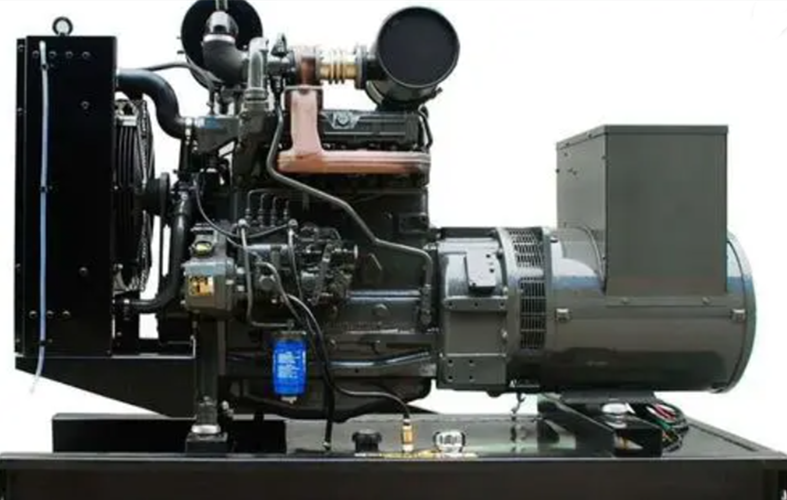Warum macht ein Dieselmotor Lärm und wie kann man ihn reduzieren?
A diesel generator set is a kind of small power generation equipment, which takes diesel as fuel and diesel engine as prime mover to drive the generator to generate power. The whole set is generally composed of diesel engine, generator, control box, fuel tank, starting and control storage battery, protection device, emergency cabinet and other components. It can be fixed in a place, also positioning use and mounted on the trailer for mobile use. A diesel generator set is a non-continuous operation of power generation equipment, if the continuous operation of more than 12h, its output power will be about 90% lower than the rated power. Despite the low power of diesel generator set, it is still a power supply source for many applications because of its small size, flexibility, portability, complete set, easy to operation and maintenance. Diesel generator sets usually produce noise of 95-110db(a) during operation, which will cause noise pollution to the surrounding environment. So what measures can be taken to control the noise pollution of diesel generator sets when the noise source cannot be reduced?

First of all, we have to understand where the diesel generator noise comes from. Diesel engine noise is a complex sound source composed of many kinds of sound sources. According to the way of noise radiation, it can be divided into aerodynamic noise, surface radiation noise and electromagnetic noise. According to the source, the surface radiated noise of diesel generator set can be divided into combustion noise and mechanical noise. Aerodynamic noise is the main source of diesel engine noise.
- Aerodynamic noise is the diesel generator noise generated by the disturbance of gas and the interaction between gas and objects due to the unstable process of gas. Aerodynamic noise radiated directly into the atmosphere, including intake noise, exhaust noise and cooling fan noise.
- Electromagnetic noise is the diesel engine noise generated by high-speed rotation of the generator rotor in the electromagnetic field.
- It is difficult to strictly distinguish between combustion noise and mechanical noise. Generally, diesel engine noise caused by pressure fluctuation caused by combustion in the cylinder of diesel generator set radiates outward through the cylinder head, piston, connecting shaft, crankshaft and body is collectively referred to as combustion noise. The noise of diesel engine set caused by the impact of piston on cylinder liner and the mechanical impact of moving parts is called mechanical noise. Generally, the combustion noise of direct-injection diesel engines is higher than the mechanical noise, while the mechanical noise of non-direct-injection diesel engines is higher than the combustion noise. However, combustion noise is higher than mechanical noise at low speed.
How to control diesel generator noise?
Sound proof room
After the exhaust noise of the unit and the noise of the cooling fan are reduced, the mechanical noise and combustion noise of the diesel engine are left. In the soundproof room, except the necessary inner wall observation window connected with the observation room, the other Windows are removed. All holes should be sealed tightly. The sound insulation quantity of the brick wall should be above 40db(a). The doors and Windows of the equipment room are fireproof and sound-proof. Install the sound insulation room at the position of the diesel generator set, the size of which is 8.0m×3.0m×3.5m, and the outer wall of the sound insulation board is 1.2mm galvanized sheet. The inner wall is a 0.8m perforated plate, and the filling material in the middle is 32kg/m3 ultra-fine glass wool. The groove surface of the channel steel should be filled with glass wool.
Inlet air and exhaust air
Ventilation and heat dissipation in the equipment room must be solved after sound insulation. The air intake should be set in the same straight line as the generator set and the exhaust outlet. The air inlet should be equipped with a resistive chip muffler. Because the pressure loss of the air inlet is also within the allowable range, the air volume in and out of the equipment room can be naturally balanced, and the ventilation and heat dissipation effect is obvious.
The natural air inlet muffler is installed on the sound insulation roof, which is similar to the exhaust muffler. The net muffler length is 1.0m, the section size is 3.4m× 2.0m, the thickness of the muffler is 200mm, the spacing is 200mm, and the muffler is connected with an unlined 90° muffler elbow, and the muffler elbow is 1.2m long.
Exhaust noise is the main noise source of the unit, which is characterized by high noise level, fast exhaust speed and difficult control. The special impedance compound muffler can generally reduce the exhaust noise by 40-60db(a). The diesel generator set relies on its own fan to exhaust air. The rectangular muffler of AES type is installed in the front of the exhaust room. The size of the muffler is 1.2m×1.1m× 0.9m. The muffler is made of galvanized perforated plate on both sides with superfine glass wool structure. 9 silencers of the same size are assembled into a 1.2m×3.3m×2.7m large silencer. Exhaust louvers of the same size are located 300mm in front of the muffler.
Indoor air communication
Good sound insulation in the machine room will make the air in the room not convection when the closed water-cooled generator set is shut down, and the high temperature in the room cannot be timely lowered. In this case, the problem can be solved by using a low-noise axial fan and a resistance chip muffler.
Vibration isolation of unit
Before the installation of the generator set, vibration isolation processing should be strictly in accordance with the data provided by the generator manufacturer to avoid the long-distance transmission of structural sound and continuous emission of air sound in the transmission. For the existing generator set whose noise exceeds the standard, the vibration of the ground near the generator set must be measured. If the vibration sensation is obvious, the generator set should be isolated first.
Noise absorbing
Several types of noise-absorbing technologies are used to reduce diesel generator noise. These include acoustic enclosures, attenuators, and structural sound control. A special sound-attenuating enclosure combines barrier noise control with absorption noise control.
Acoustic enclosures for diesel generators are specially designed to attenuate the sound of the enclosed machine. Most diesel generators have mufflers that absorb the noise from engine combustion. The mufflers are typically made of reactive material that absorbs low-frequency sounds. There are also combination mufflers that contain both low and high-frequency sounds. Acoustic enclosures can be made from a variety of materials, including steel, aluminum, and concrete. Some are designed to be corrosion-resistant in salt air. The design of these enclosures should be based on the predominant noise frequencies. Depending on the type of muffler, the design should also be based on the temperature and ambient humidity.


